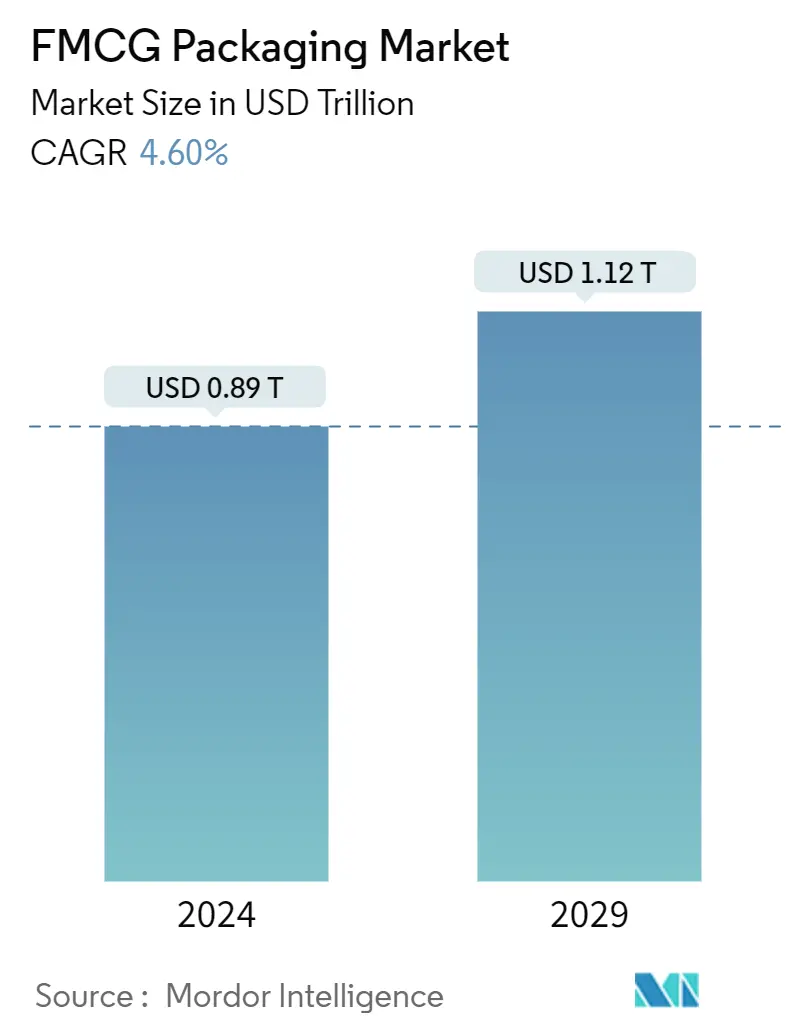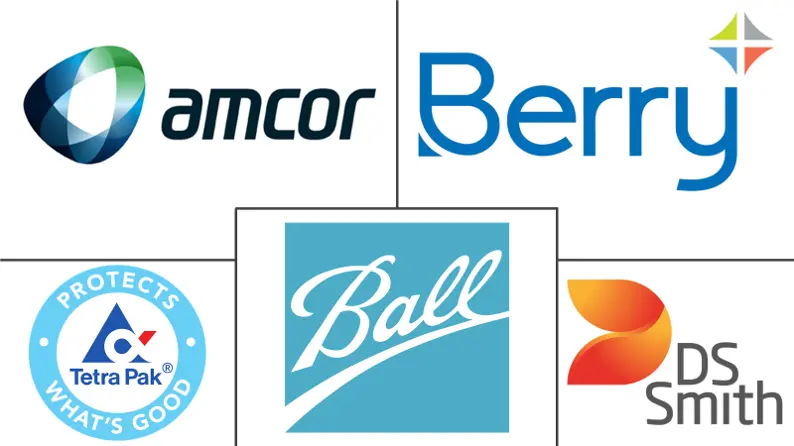Market Size of FMCG Packaging Industry

| Study Period | 2019 - 2029 |
| Market Size (2024) | USD 0.89 Trillion |
| Market Size (2029) | USD 1.12 Trillion |
| CAGR (2024 - 2029) | 4.60 % |
| Fastest Growing Market | Asia Pacific |
| Largest Market | North America |
Major Players
*Disclaimer: Major Players sorted in no particular order |
Need a report that reflects how COVID-19 has impacted this market and its growth?
Fast-Moving Consumer Goods (FMCG) Packaging Market Analysis
The FMCG Packaging Market size is estimated at USD 0.89 trillion in 2024, and is expected to reach USD 1.12 trillion by 2029, growing at a CAGR of 4.60% during the forecast period (2024-2029).
The food and beverage industry is going through enormous changes due to changing consumer preferences, which prompt FMCG companies to adopt new technologies and measures to offer packaging on par with the changing trends. Packaging vendors are adopting modern packaging technology to improve the quality of packaging to serve a more extensive range of customers (FMCG companies) and to enable them to achieve product differentiation.
- The transportation of packed goods and consumables can have adverse effects and reduce the packaged contents' nutritional value. More and more hyperlocal supply chains are emerging with consumers' desire to have information about the origin of food products. With the recent trend of private labels, big retailers are ramping up their packaging to attract customers. According to a survey conducted by Daymon, more than half of consumers are loyal to a specific store due to its private-label brands. Moreover, the report also found that 85% of consumers believed they trust a private brand just as much as a national brand and 81% said that they purchase an individual brand product during every shopping trip.
- The FMCG industry in India increased due to consumer-driven growth and rising product costs, particularly for necessities, according to the India Brand Equity Foundation (IBEF). About 3 million people are employed in the FMCG industry, which accounts for about 5% of all manufacturing jobs in India. The nation's revenue growth for FMCG sales was projected to increase by 7-9% in 2022-2023. Favorable government efforts and policies, a growing rural market and young population, newly branded items, and the development of e-commerce platforms are some of the sector's main growth factors.
- Modern developments in seafood packaging are becoming more sophisticated and more attuned to the social inclinations touted by consumers, retailers, and for essential food service buyers who shop for them. The sustainability of seafood has been a robust trend promoting a healthy seafood resource for generations. The same idea is now being focused on the viability of packaging used to protect and ship seafood. According to consumer-facing packager Bemis, the concern for sustainable practices from all areas of the supply chain is expected to continue to increase. Many beverage companies are interested in transforming their packaging, switching from bottles to aluminum cans for water, and introducing interactive digital platforms.
- Concerns and awareness about the effects of packaging waste produced by the FMCG sector on the environment are rising. Single-use packaging, particularly plastic packaging, has drawn criticism because it contributes to pollution, litter, and landfill waste. Finding environmentally acceptable alternatives is problematic for FMCG firms due to expanding environmental restrictions and customer demand for sustainable packaging solutions.
- With the outbreak of COVID-19, consumer goods were considered necessity products and did not react to slowdowns as much as products in other sectors. COVID-19 significantly boosted e-commerce due to lockdowns and limitations on traditional shops. Consumers increasingly bought FMCG items online, which increased the need for packaging for safe and effective shipment. This increased demand for packaging options appropriate for e-commerce, such as robust materials, small-footprint constructions, and optimized container sizes. Further, the Russia-Ukraine war had an impact on the overall packaging ecosystem.
